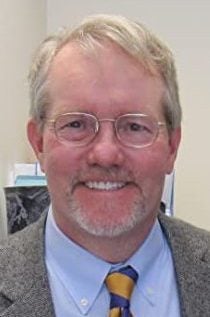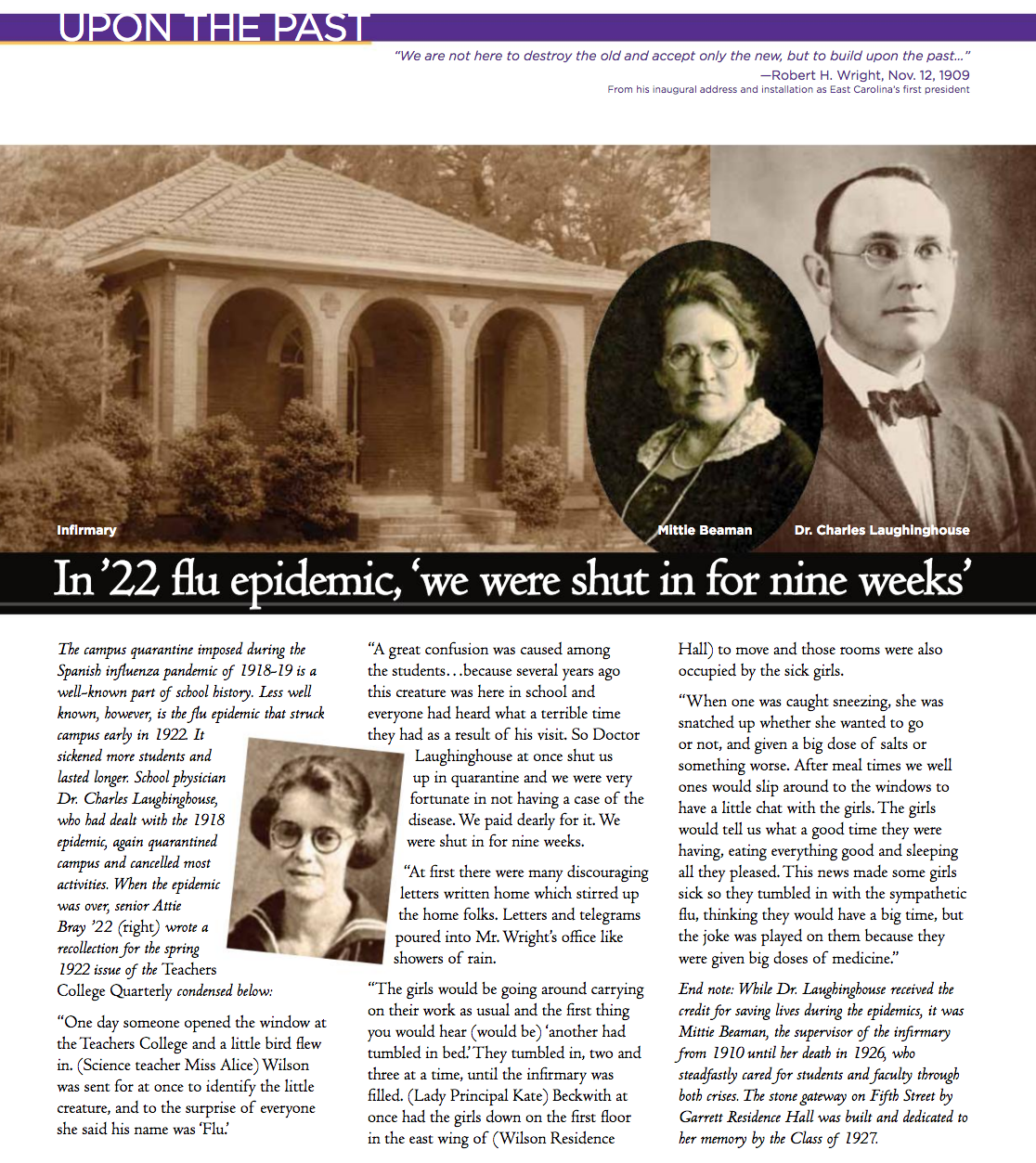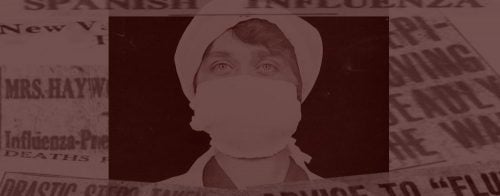WATERSHED EVENT
Faculty members share how COVID-19 pandemic might be taught to future students
The COVID-19 pandemic has been a watershed event that will be discussed, researched, analyzed and eventually placed in a broader historical perspective, according to East Carolina University faculty members who recently shared their thoughts on how the period might be taught to future students.

Oakley (Contributed photo)
Dr. Christopher Oakley, chair and associate professor in ECU’s Department of History in the Thomas Harriot College of Arts and Sciences, teaches American history from the end of Reconstruction to the present. Eventually — probably in the next 5-10 years — he will include the 2020 pandemic in his course.
“Our understanding of this event will evolve for decades,” Oakley said. “Initially, we will focus on the basics. What was the virus? How did it spread? What were the consequences (medical, political, economic, and social)? And how did leaders respond? Eventually, we will look at more complex questions as we gather more information. And we will learn more about consequences and outcomes.”
However, Oakley said historians are already finding ways to incorporate classroom exercises related to the pandemic.
One history professor at another university attracted attention on Twitter after asking his students what artifact should be included in a future museum exhibit about the pandemic. “The answers included the obvious things: a roll of toilet paper, a mask, etc. But some had more creative answers, such as uncompleted school assignments,” Oakley said.
Others are using oral history, where students interview people about their experiences during the pandemic. “These interviews can then become primary sources for students and academics in the future to use for research. You saw this during the Great Depression as well,” Oakley said.
Looking forward
Dr. Shannon Vance, teaching assistant professor of history, said while historians are accustomed to looking backward instead of projecting or forecasting, she expects the pandemic to provide many topics to explore.

Vance (Contributed photo)
COVID-19 has exposed fragilities in society, from unequal access to health care to dysfunction in government, Vance said. But the pandemic also has shown where government works amid disruption to daily life.
“This epidemic has thrown various ongoing injustices into high relief — such as discrimination against people of color, older people and immigrants in the United States,” Vance said. “Speaking from an American standpoint, the COVID-19 epidemic will be inextricably linked to the Trump presidency. Future historians will debate this presidency’s failures and successes, and much of it will revolve around COVID-19 and its impact on law, health care and economics.”
Short- and long-term changes that occur will be studied, Vance said. “What aspects of society will shift, what elements will continue to exist much as before? People living in this time will never forget COVID-19. Mistakes, errors and timing will be analyzed. Heroes will be remembered. Leadership will be praised or pilloried.”
Another aspect is the use and proliferation of social media, and the shift to learning and working from home, Vance said.
“I foresee that historians will note the move online but will also note the ways human beings missed connecting with other humans,” Vance said. “They will note how education occurs best in community and in relationship. Future historians will also note, however, that some meetings, some work, can be just as effectively accomplished from home, perhaps cutting down on commuting and fixed costs such as expensive buildings.”
With kitchens and living rooms turned into makeshift classrooms, Vance said she hopes people will appreciate the amount of hard work and care that teachers provide children. As a mother and as a daughter, Vance said she has been dismayed by the cavalier attitude of some people toward the danger that COVID-19 presents. “The muddying of ‘rights’ with ‘social responsibility’ has been something that I believe historians will analyze in the future,” she said. “How do we balance the need for public safety and for consideration of others with personal freedoms and rights?”
Past pandemics
Lessons from the past
These books would be on ECU’s Dr. Christopher Oakley and Dr. Shannon Vance’s reading lists for a future class on the COVID-19 pandemic:
“Plagues and People” by William McNeill
“The Columbian Exchange” by Alfred Crosby
“Silent Travelers: Germs, Genes, and the Immigrant Menace” by Alan M. Kraut
“The Great Influenza: The Story of the Deadliest Pandemic in History” by John M. Barry
University Historian Dr. John Tucker has written about the 1918 flu pandemic — which has some similarities to today — and its impact on ECU’s campus more than 100 years ago.
Previous pandemics and epidemics — from Black Death and smallpox to the Spanish flu and Ebola — offer many lessons that could be included in a future course syllabus. In addition to COVID-19, terms would include personal protective equipment, shelter in place and social distancing.
“I hope that we learn more this time than we have from previous pandemics,” Oakley said. “Historians have been studying the effects of pandemics for a very long time. The lessons are there for those that want to learn.”
While the height of the Black Death plague occurred in Europe and the Middle East from 1347 to 1351, aftershocks were felt as late as the early 1700s, Vance said. Populations were cut by a third to half in Europe, China and India.
“Although the plague did not discriminate between rich and poor in its transmission and death rates, the rich barricaded their households and the poor suffered disproportionally,” Vance said. “Interestingly, the first quarantine was established in 1377 at the Adriatic port of Ragusa, and by the 1460s quarantines were routine in the Mediterranean.”
Vance said she would have students study the far-reaching effects of the plague in religion, science, society and state building.
The smallpox epidemic — brought to the New World by Europeans — had an extremely high death rate for indigenous Americans who had no immunity to the disease. “Entire people groups died. It weakened societies and destroyed networks of trade,” she said. “We would also discuss how smallpox was weaponized. The American government actually gave blankets infested with smallpox to Native Americans on purpose to infect them.”
The syllabus would also cover how disease was racialized during colonization by imperial powers, Vance said.
Perhaps the best historical analogy to the coronavirus crisis is the Spanish flu pandemic of 1918, just a few years after ECU was founded. An estimated 500 million people worldwide were infected by the flu pandemic, resulting in up to 50 million deaths globally and 675,000 in the United States.

Tucker (Contributed photo)
“The 1918 pandemic was similar, but then East Carolina Teacher’s Training School had only 300 students; now we have nearly 30,000 and they’re from all over the state and nation, even some international students, not to mention an older faculty,” said Dr. John Tucker, professor of history and university historian. “We are more vulnerable now than then, but also far more informed and hopefully better prepared to deal with COVID as a smart, educated and well-informed community.”
Between 1918-20, more than half the students on ECU’s campus contracted the flu, which resulted in the death of a recent graduate. Students were quarantined on campus during parts of the school year and events were canceled.
“We are now living through a momentous period in ECU history that will be remembered by all for the remainder of our lives,” Tucker said. “Our memories will be shared with those at other colleges and universities, compared and contrasted, laughed at and cried over for decades to come.”
As ECU gears up to welcome back students, faculty and staff on Aug. 10, face coverings, frequent handwashing and social distancing will be required.
“Students are both excited and anxious about the fall, raring for a return to normal but cognizant that we are not done with COVID yet,” Tucker said. “Hopefully they will meet the challenges with the smart resilience that defines the Pirate Nation. I’m hoping to see a sea of purple and gold masks.”


